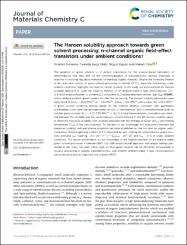| dc.contributor.author | Deneme, Ibrahim | |
| dc.contributor.author | Yıldız, Tevhide Ayça | |
| dc.contributor.author | Kayaci, Nilgun | |
| dc.contributor.author | Usta, Hakan | |
| dc.date.accessioned | 2024-03-18T12:37:08Z | |
| dc.date.available | 2024-03-18T12:37:08Z | |
| dc.date.issued | 2024 | en_US |
| dc.identifier.issn | 2050-7526 | |
| dc.identifier.uri | https://doi.org/10.1039/d4tc00324a | |
| dc.identifier.uri | https://hdl.handle.net/20.500.12573/2014 | |
| dc.description.abstract | The adoption of green solvents is of utmost importance for the solution-based fabrication of
semiconductor thin films and for the commercialization of (opto)electronic devices, especially in
response to evolving regulatory mandates for handling organic materials. Despite the increasing interest
in this area, the scarcity of green solvent-processed n-channel OFETs, especially functioning under
ambient conditions, highlights the need for further research. In this study, we demonstrated the Hansen
solubility approach to study the solubility behavior of an ambient-stable n-type semiconductor, 2,20
-
(2,8-bis(3-dodecylthiophen-2-yl)indeno[1,2-b]fluorene-6,12-diylidene)dimalononitrile (b,b0
-C12-TIFDMT),
and to analyze potential green solvents for thin-film processing. The Hansen solubility parameters were
determined to be dD = 20.8 MPa1/2, dP = 5.8 MPa1/2, and dH = 5.5 MPa1/2 with a radius (R0) of 8.3 MPa1/2.
A green solvent screening analysis based on the minimal distance constraint and quantitative
sustainability score identified ethoxybenzene, anisole, 2-methylanisole, and 2-methyltetrahydrofuran as
suitable green solvents (Ra0s = 5.17–7.93 MPa1/2 o R0). A strong thermodynamic correlation was identified between the solubility and the semiconductor–solvent distance in the 3D Hansen solubility space,
in which the maximum solubility limit could be estimated with the enthalpy of fusion (DHfus) and melting
temperature (Tmp) of the semiconductor. To the best of our knowledge, this relationship between the
maximum solubility limit and thermal properties has been established for the first time for organic semiconductors. Bottom-gate/top-contact OFETs fabricated by spin-coating the semiconductor green solutions exhibited mes reaching B0.2 cm2 V1 s
1 (Ion/Ioff B106
–107 and Von B0–5 V) under ambient
conditions. This device performance, to our knowledge, is the highest reported for an ambient-stable
green solvent-processed n-channel OFET. Our HSP-based rational approach and unique findings presented in this study can shed critical light on how green solvents can be efficiently incorporated in
solution processing in organic (opto)electronics, and whether ambient-stable n-type semiconductors
can continue to play an important role in green OFETs. | en_US |
| dc.description.sponsorship | H. U., I. D., T. A. Y., and N. K. acknowledge support from the Scientific and Technological Research Council of Turkey (TUBITAK) (grant no. 121C261). We thank Prof. Gokhan Demirel and Prof. Fahri Alkan for fruitful discussions. | en_US |
| dc.language.iso | eng | en_US |
| dc.publisher | Royal Society of Chemistry | en_US |
| dc.relation.isversionof | 10.1039/d4tc00324a | en_US |
| dc.rights | info:eu-repo/semantics/openAccess | en_US |
| dc.title | The Hansen solubility approach towards green solvent processing: n-channel organic field-effect transistors under ambient conditions | en_US |
| dc.type | article | en_US |
| dc.contributor.department | AGÜ, Mühendislik Fakültesi, Malzeme Bilimi ve Nanoteknoloji Mühendisliği Bölümü | en_US |
| dc.contributor.authorID | 0000-0001-9415-0242 | en_US |
| dc.contributor.authorID | 0000-0002-0618-1979 | en_US |
| dc.contributor.institutionauthor | Deneme, Ibrahim | |
| dc.contributor.institutionauthor | Yıldız, Tevhide Ayça | |
| dc.contributor.institutionauthor | Kayaci, Nilgun | |
| dc.contributor.institutionauthor | Usta, Hakan | |
| dc.identifier.volume | 11 | en_US |
| dc.identifier.startpage | 1 | en_US |
| dc.identifier.endpage | 11 | en_US |
| dc.relation.journal | Journal of Materials Chemistry C | en_US |
| dc.relation.publicationcategory | Makale - Uluslararası Hakemli Dergi - Kurum Öğretim Elemanı | en_US |


















